How a raucous, festive dish created by four Heavenly Kings conquered a country obsessed with eating.
Every year, in Singapore, my family gathers for the traditional reunion dinner on the eve of the Chinese New Year. It’s always a moderately stressful affair.
This year, we’re at Red Star Restaurant, the grand old dame of Chinese restaurants in Singapore. Opened in the 1960s, the cavernous interior is a dragon matriarch’s den of dusty 80s décor, grumpy sexagenarian waitresses, and shades of lipstick-red. Here, ‘vintage’ is the present and ‘kitsch’ is an alien concept. For the elders in the family, it’s a comforting reminder of the past century. For the young ones, it’s almost hip.
“So, do you have a boyfriend yet?” comes the undeviating question from Aunt Angeline, as Aunt Angela sucks on a sour plum sweet and gazes attentively at me.
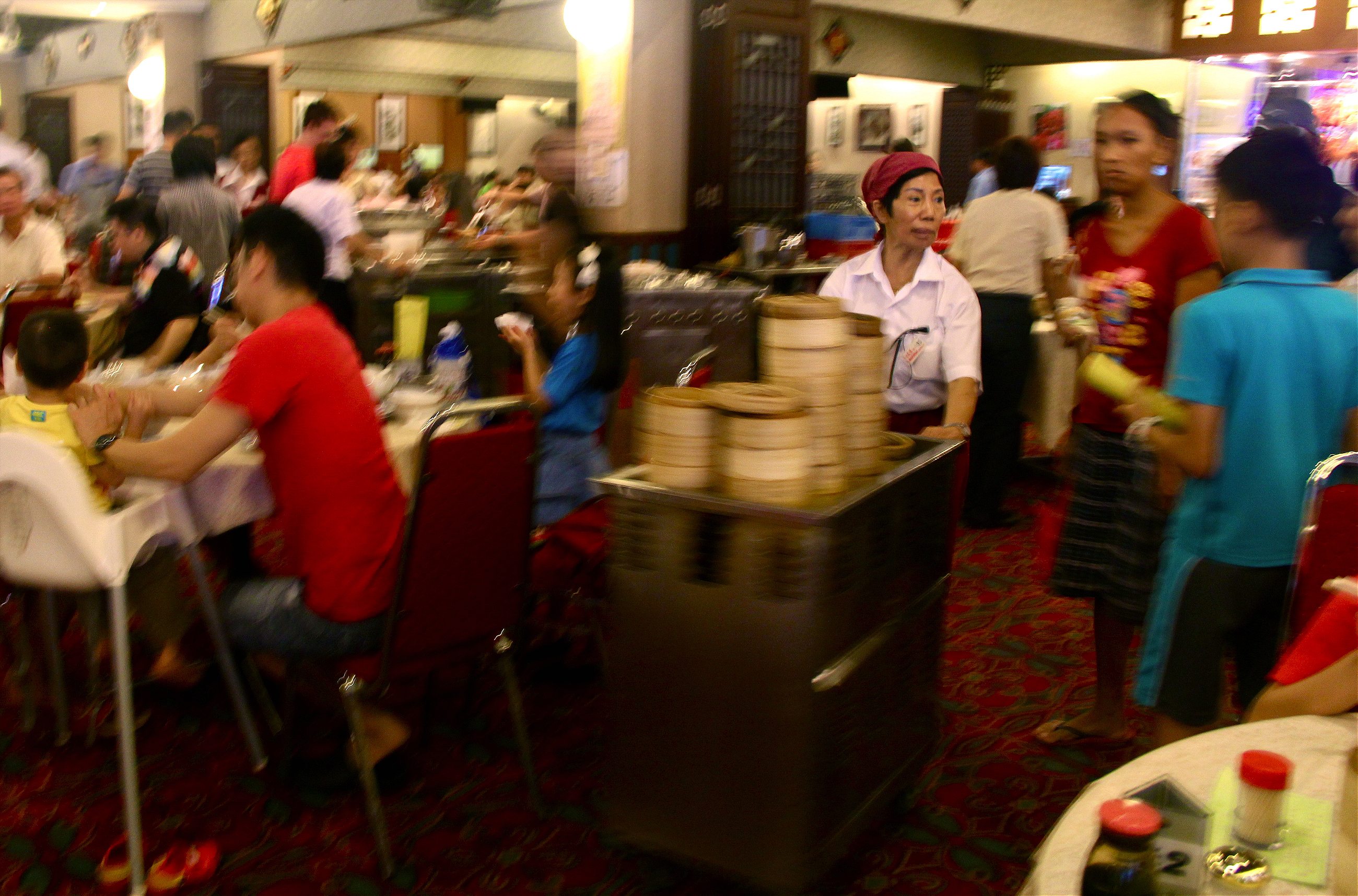
The siege comes hard and fast, leaving me a raw snail, exposed and defenseless. “Are you still working your old job? Do you get paid more now? Aiyoh, still so little; you’d better ask your boss for a raise! You’ve put on some weight, ah? If you continue like this, how to find husband?”
Infant cousins patter around the table, coming precariously close to yanking the starched white tablecloth. Fathers sit out the ordeal, using iPads as social armor while sipping on tepid glasses of Chinese tea.
But then, cutting a divine swathe through this peculiar, very Singaporean mélange of goodwill and ennui, comes the food. The grand parade of dishes—sticky nian gao; double boiled chicken soup; braised pork trotters; the extravagance of poon choy— subsumes forced conversation. Come 7 p.m., all probing enquiries about the doomed future of today’s youth are shoved to the side as the invariable first course hits the table: the Technicolor vision that is yusheng.

Yusheng translates literally from Cantonese to ‘raw fish’, referring to the slices of salmon or ikan parang (the Malay term for wolf herring) that top the dish. But the words are also homonyms for ‘a rising of abundance’— adding to the dish’s symbolic pertinence to the New Year. Besides fish, the dish also comprises generous rainbow-mounds of shredded radish and carrot, pickled ginger and assorted melon strips, dried orange peel, and pomelo segments.
As the final accouterments—chopped peanuts, sesame seeds, deep-fried flour crisps, oil and plum sauce—are added to the mix, each is accompanied by the recitation of a set of luck-engendering phrases. In probably no other culture are culinary items burnished so wittily by wordplay, especially, it seems, when it comes to the twin bastions of wealth and luck.
The flour crisps, resembling gold ingots of yore, are followed by cries of ‘pian di huang jin’ (or, ‘floor full of gold’).
In go the sesame seeds and chopped peanuts. Uncle Anthony will yell “sheng yi xing long!” (Or, ‘a flourishing business’.)
Then, a generous dash of olive oil, symbol of a smooth year ahead. “Cai yuan giang jin!”, goes my mother. Wealth arrives.
“Tian tian mi mi!” Cousin Bryan swirls in the thick plum sauce, hoping for a ‘sweet life’.
Once everyone is rallied and smushed uncomfortably around the table like kids at a class photo, a strange and raucous ritual called lohei (‘tossing up’) begins.
(A quick note on etymology here. Yusheng refers to the dish; lohei, the ritual. But the two are an inseparable pair—no other dish invites the ritual, and vice versa. They’re, to put it in the words of today’s doomed youth, exclusive.)
READY, SET, GO—CHAOS
All participants stand at attention. Some affect athletic poses, like runners at the mark. Ready, set, go—chaos.
Amidst more cries for unprecedented fortuitousness, the chopsticks stab mercilessly into the pile of vegetables and the tossing begins. Tradition dictates that the higher the ingredients fly, the better the luck. And so radish, fish slices, melon strips, et al., soar to heights of almost six feet before returning to the plate. There is splattering. Chopsticks get lost in the melee. Sesame seeds have been known to end up in an aunt’s coif. Clean hands are definite casualties—all are well and greased by the end. But what you get is a superbly mixed, Pollock-esque salad spanning the table.
Then suddenly, abruptly, it’s over. Plates appear. Portions are doled equally and distributed. Cousins, siblings, aunts, uncles descend into a companionable silence. We are absorbed in a dish that is by turns cool, sticky, tangy, sweet, crunchy, nutty and sour, occasionally unearthing the happy surprise of a soft, oily slice of raw salmon. Absorbed in the frank deliciousness of a dish made, if not exactly with love, then with joyous camaraderie.
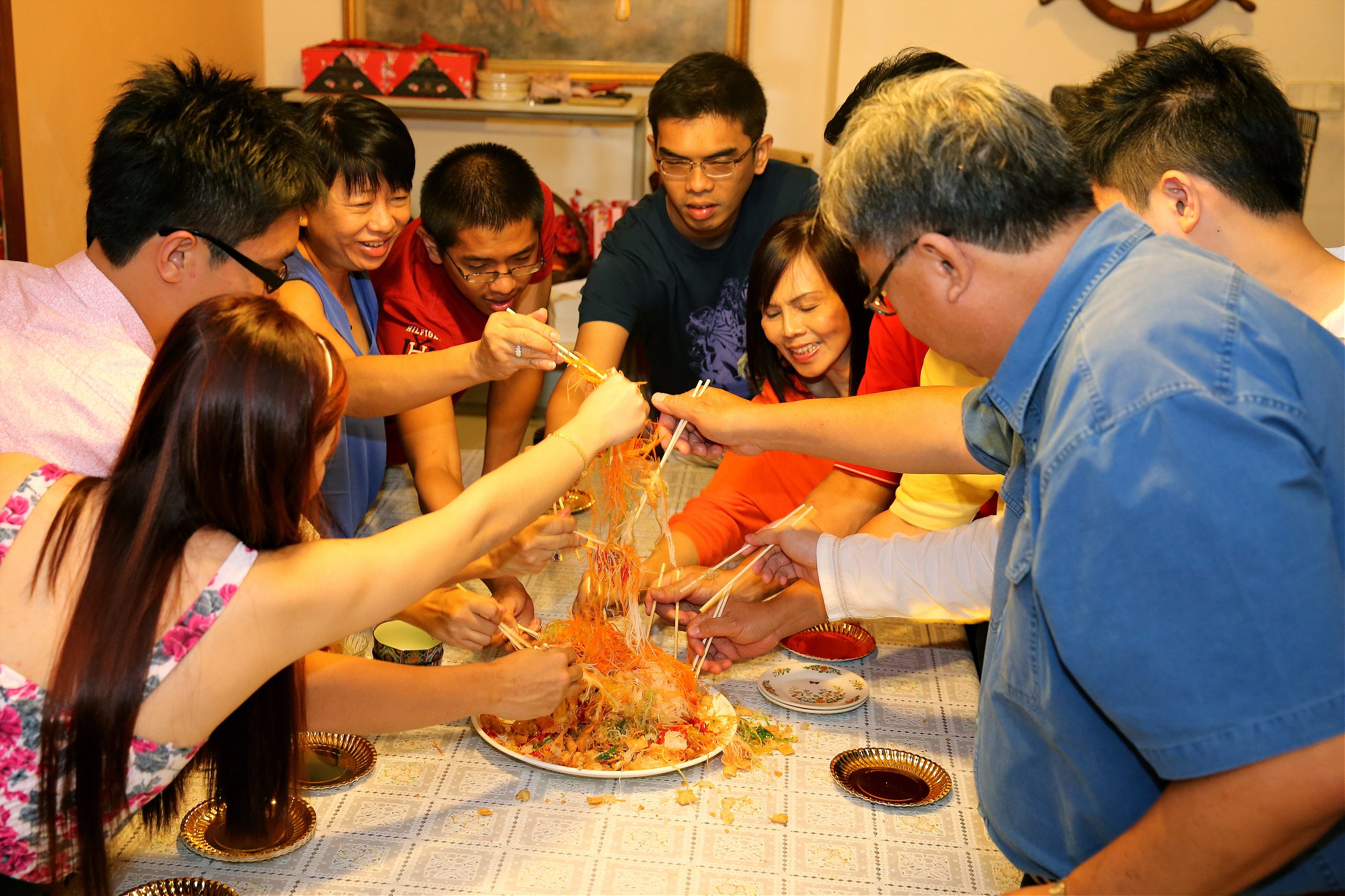
Judging by the nigh-religious fervor with which my countrymen recklessly devour the dish throughout 15 days of the Lunar New Year, one would think it boasts a millennia-spanning lineage and the scrubbed patina of history. In fact, the dish was invented just 50 years ago as a strategic marketing ploy by four shrewd chefs called the Four Heavenly Kings.
First, some history. We know yusheng originated in Guangdong, China, as a vastly different creature. Since the 1920s, it was typically eaten by fishermen in cities like Jiangmen and Shunde on Ren Ri (literally, ‘Human Day’), the 7th day of the Lunar New Year, to celebrate their bounty. Instead of the unabashed explosion of color and flavor, their version was humble: thin slices of raw common carp mixed with soy sauce, vinegar, peanut oil, pickled shallots and shredded vegetables.
As for the tossing ritual? Absent. Yusheng was consumed with as much pomp and fanfare as popping an aspirin.
What we are devouring today was created only in 1964, by Tham Yui Kai, Lau Yoke Pui, Sin Leong and Hooi Kok Wai—the Beatles of the local Canto-cuisine scene at the time. They had apprenticed together under legendary Master Chef Lo Peng at yet another iconic restaurant, The Cathay, and had formed a tight lifelong brotherhood. In fact, their kitchen chops were so revered that they were dubbed the ‘Four Heavenly Kings’ in an allusion to the four deities of the Buddhist faith, each of whom looks out towards one cardinal direction of the world.
And happily, for the world, they decided one Chinese New Year to spruce up a traditional Cantonese dish to improve business.
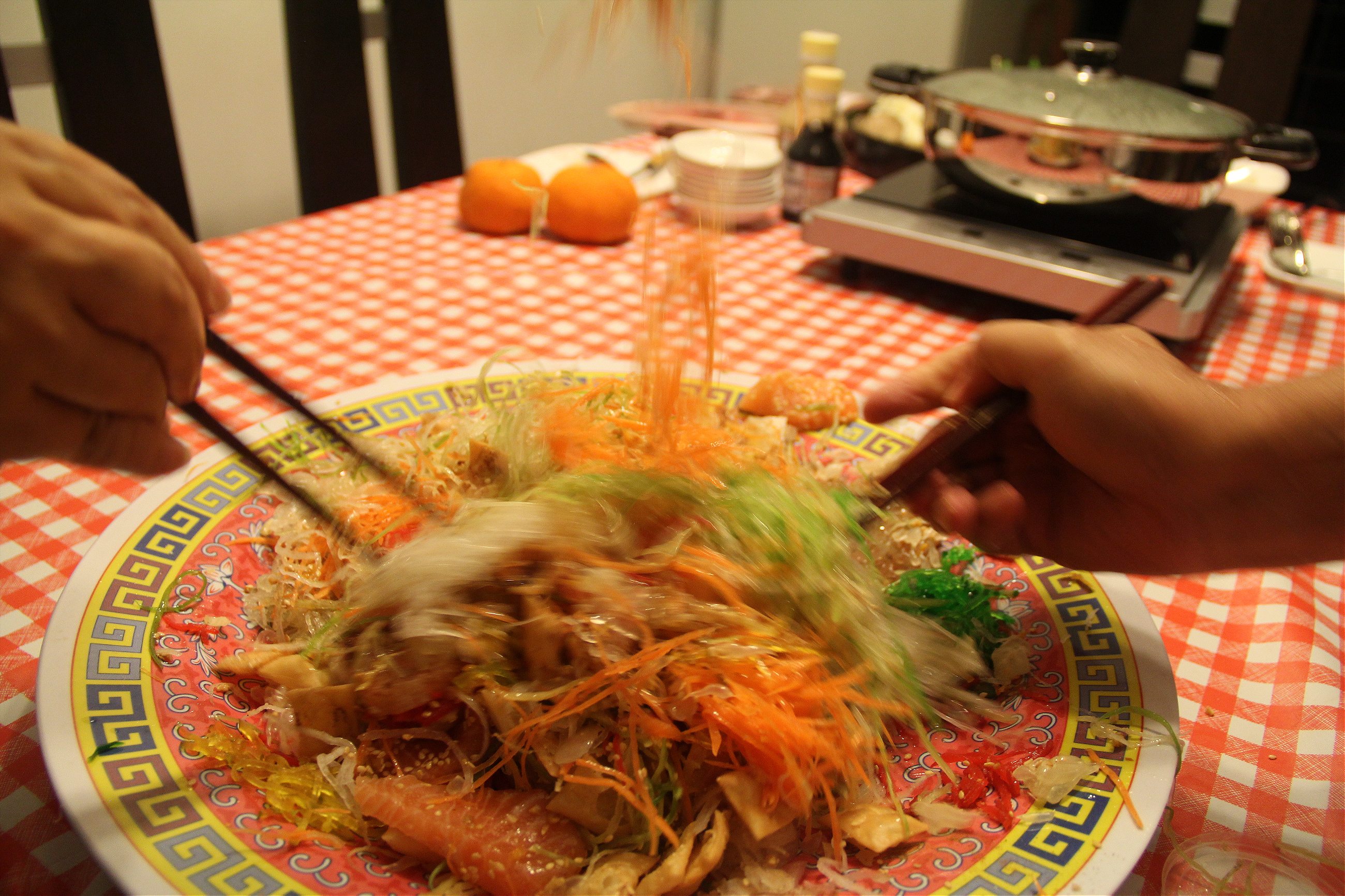
I was invited this past Chinese New Year to the launch of a new television program that traces the origins of iconic festive dishes. Yusheng was on the list, and the two surviving Heavenly Kings – Sin Leong and Hooi Kok Wai – were there to give a demonstration.
Both of them are in their 80s, yet miraculously maintain a head of black hair. It must be the joy of work – Sin still oversees operations at Red Star every day, while Hooi does the same at his enterprise, Dragon Phoenix Restaurant. Sin, the older of the two, has eyes perpetually crinkled in mirth and a voice hoarse with decades of instructing over the roar of woks.
“We wanted to improve the fragrance, colour and flavour of yusheng,” he says. “We chose vegetables that were orange, green and white. Ingredients like sesame seeds, crushed peanuts and flour crisps added depth and texture.”
“The final element was the sauce,” adds Hooi’s son, Chris, who also works at Dragon Phoenix. “Initially, diners had to mix their own dressing with the sugar, vinegar and oil we provided. The ratios were never completely perfect, so [the four chefs] concocted a standardized mixture of plum sauce, kumquat paste, rice vinegar and sesame oil to give the dish its distinctive flavor, its identity.”
Our conversation is interrupted as Sin and Hooi begin assembling a yusheng platter that’s approximately the size of a lazy Susan. Even after decades of making the same dish, their enthusiasm is palpable—Sin yelling out a running commentary in Cantonese into his lapel mike; Hooi and Chris briskly portioning out fresh mounds of radish and pickles in a nimble gastro-tribal dance.
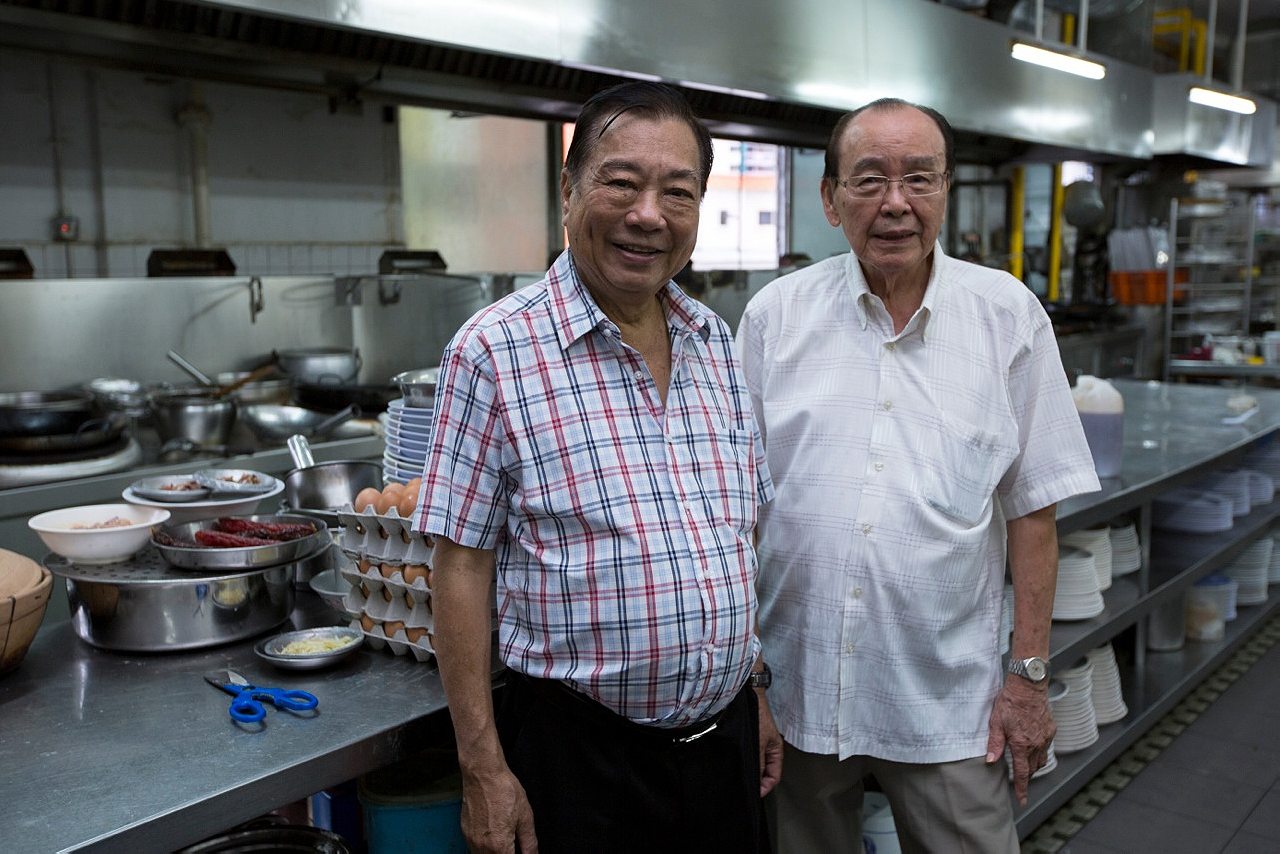
Although it took six years after its creation for the dish to catch on—traditionalists felt that tossing their own food was too much work at a restaurant—catch on it did. Customers got in on the action by gradually attaching phrases to each ingredient; organically forging the oddly standardized script that all partakers of yusheng recite today. Culinary memes, so to speak, were created in a pre-internet age.
Today, a Singaporean Chinese New Year celebration without this dish is a little like Oktoberfest without the beer—unthinkable. Every year, hotel, restaurant and supermarket proprietors grow fat on the manna of yusheng’s cash flow. Ready-made versions are snapped up like hot potatoes for home affairs, while banquet master chefs try to outdo one another with obnoxious luxury—a previous iteration this year at Singapore’s Grand Park City Hall Hotel, featuring precious slices of raw abalone, lobster, geoduck, salmon, Japanese amberjack, caviar and fish roe, went for the ‘auspicious’ price of SGD$888 (USD710).
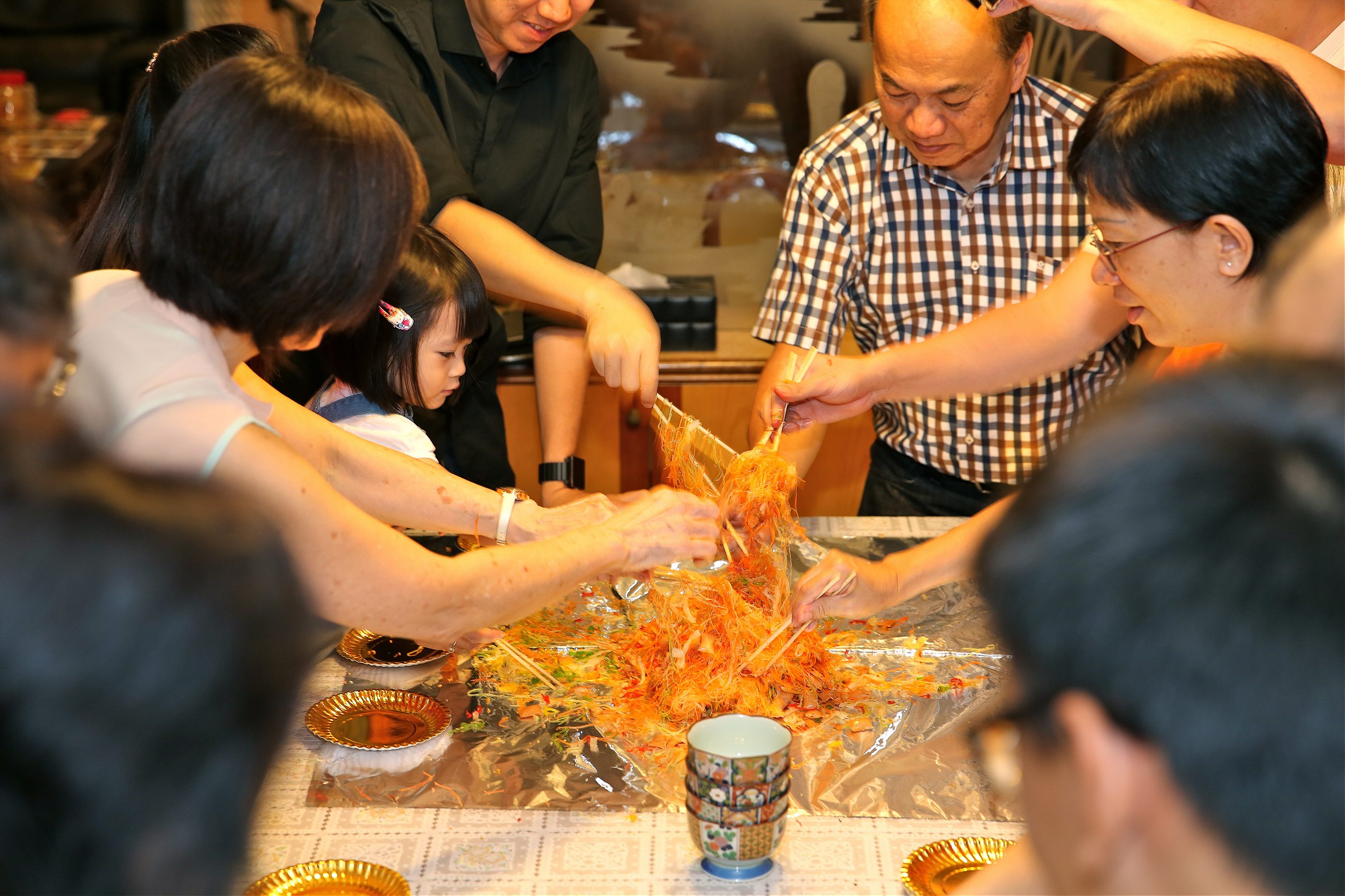
In 2010, Professor Tan Wee Cheng from the National University of Singapore postulated publicly on Facebook that yusheng should be considered as Singapore’s national dish in the UNESCO Intangible Cultural Heritage list. The poor man unwittingly incited a vicious cross-border spat. In the face of Singaporeans’ impassioned support, Malaysian Tourism Minister Ng Yen Yen responded icily with: “We cannot continue to let other countries hijack our food”. (This was in reference to yet another fight a few years previously, this time pertaining to the origins of Hainanese chicken rice.) Internet warriors called it a “deliberate violation of rights”, arguing that the dish originated from a restaurant in Seremban, in the state of Negeri Sembilan.
While sniping at each other about food might seem trivial, we’re not the only ones. Australians and New Zealanders have been at loggerheads over pavlova for a while now. (John Key, New Zealand’s Prime Minister in 2008, dismissed Australia’s pavlova-origin claim as “totally ridiculous”.) The contentious genesis of baklava added to irritable relations between Greece and Turkey in 2006. Minced pork sausages wedged a rift between Austria and Slovenia in 2012, inciting the possibility of a cross-country lawsuit.
But the ability of food to raise such emotion is telling. It points to the deeper, more fundamental issues of national identity, culture, and belonging. And in the case of Singapore—where patriotism is at most placid; where the English Premier League is the soccer league of choice; where there is more emotional allegiance to Hollywood than to local parliament—such heartfelt outrage and crystallization of national pride is a rare show of community.
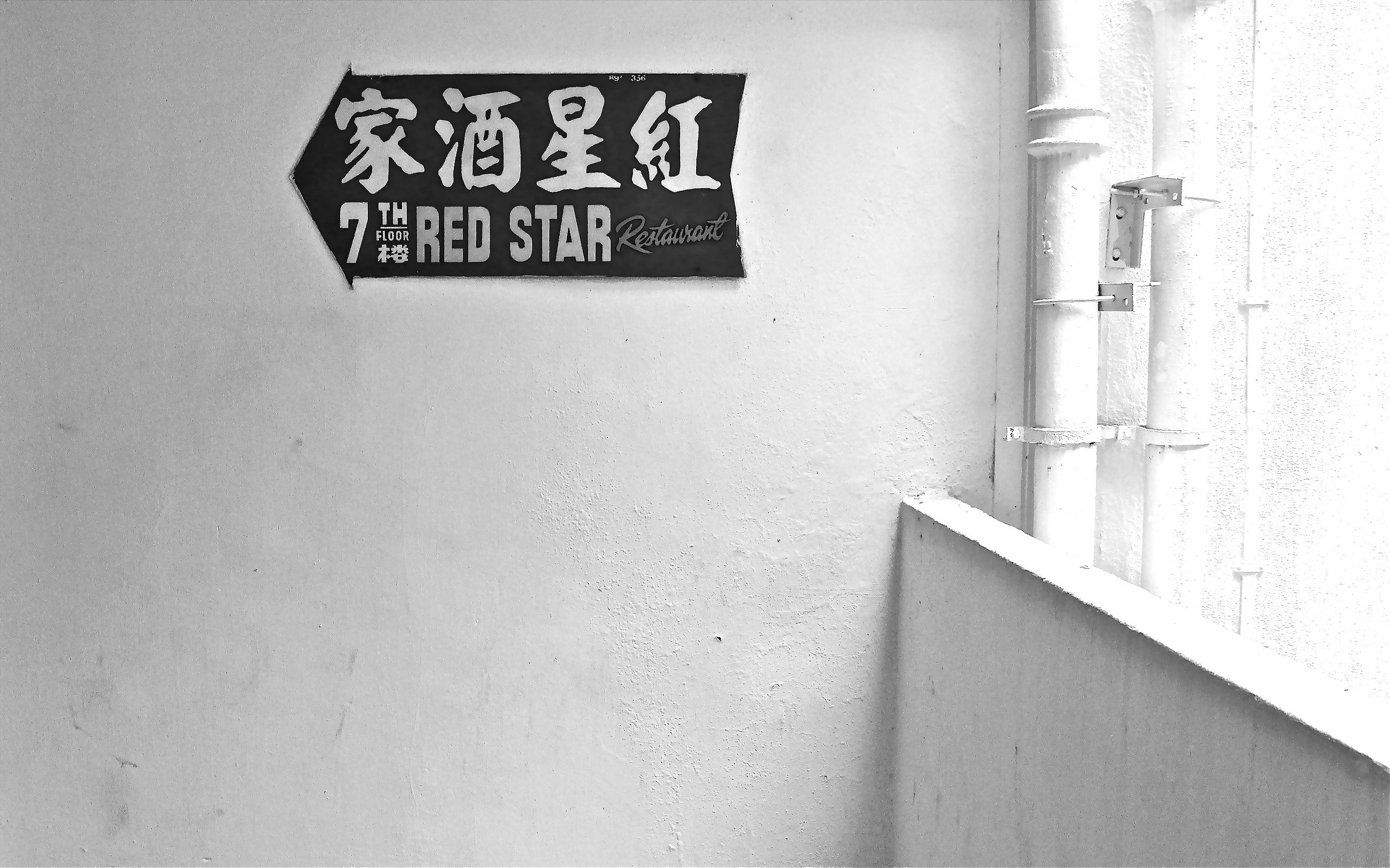
Singapore will turn 50 in 2015; a mere teenager on the global stage. She was formed by the coalescing of immigrants from China, Malaysia, India, and Britain. Today, approximately 40% of her population are foreigners who don’t hold Singaporean passports. Like an adolescent on the quivering cusp of adulthood, her identity is an understandably shaky conceit, one that the government tries—with mixed results—to manufacture and inculcate.
Take a gander, for example, at the woebegone national mascot, the Merlion. A water-spewing head of a lion is perched atop a fish tail, blithely referencing both Singapore’s original name (Singapura, meaning ‘Lion City’) and its origin as a fishing village. It was designed by Alec Fraser-Brunner in 1964, as a project for the Singapore Tourism Board to boost tourist numbers. But to this day, the mascot has raised little to no empathy in its citizens. A common refrain amongst locals is that it has no real cultural history or significance, and is no more than a smart commercial ploy. Singaporean poet, Alfian Sa’at, denounces the creature as a metaphor for the country’s flaccid sense of self. “What a riddle, this lesser brother of the Sphinx,” he writes in his poem, The Merlion.
What sibling polarity, how its sister’s lips are sealed
with self-knowledge and how its own jaws
clamp open in self-doubt, still
surprised after all these years.
SINGAPOREAN CUISINE IS CHARACTERIZED BY PANOPLY AND PASTICHE
One could say the same of yusheng—it’s a manufactured tradition of sorts, a smart commercial ploy. Why, then, has it been so thoughtlessly accepted as a source and arbiter of national pride?
The first reason is, simply, our love for food itself. Calvin Trillin wrote: “Culinarily, [Singaporeans] are among the most homesick people I have ever met.” It’s true. We adore food. Love it. That’s almost all we talk about amongst ourselves, to tourists, and to foreigners when we’re abroad. There was more pride roving the streets in July 2013, when three Singaporean hawkers triumphed over Gordon Ramsay in a local fare cook-off, than on National Day. For a small, young nation predicated on diversity, food is the great common denominator. Not everyone has the same Mother Tongue, but dammit, everyone eats.
Then there’s the very nature of Singaporean cuisine. The food of, say, France and Japan, has had the privilege of history and the long slow boil of tradition. Unlike theirs, ours is characterized by panoply and pastiche. By the yearning of immigrant communities for a faraway homeland. We have chicken rice from the Hainanese, laksa from the Peranakans. Kopi, half-boiled eggs and toast hail from British kitchens; fish head curry from the Indians. Like these dishes, yusheng was borne of the denizens of the Canton diaspora, adapting to a new country and new customs – sometimes out of sheer hygienic necessity.
“Actually, the idea for yusheng was sparked when the four of us were seated by the roadside, ordering raw fish from an itinerant stall,” recalls Chef Sin Leong, in an interview with Today, a local newspaper. “There were houseflies swarming around the fish and also smoke and dust because of the cars and motorcycles. It was bad. So we thought, ‘Why don’t we do something about this dish and bring it to the restaurants?”
NO OTHER DISH ALLOWS AN OTHERWISE RESERVED PEOPLE TO MISBEHAVE WITH SUCH INIQUITY AND TOGETHERNESS
So the thing about yusheng is—it doesn’t feel manufactured. The traditional dish is imbued with the influence of diversity, with inspiration stemming from rojak sold by local hawkers and the salads served in Western restaurants. Look a little closer, and you’ll see the nation itself reflected in the dish’s shimmering layers: modern, colorful, messy, mercantile, multivarious.
But here I am, getting all cerebral. No one really ponders the cultural implications of a dish when chowing down during festivities. There’s one more elemental reason the dish has permeated our culture so readily; one reason that speaks straight to the gut.
It’s the ritual. To lohei is to engage in a cathartic, primeval combination of consuming, chanting, communality and play. “It’s the feeling of fraternity that makes lohei so popular,” says David Yip, a Singaporean food and beverage consultant. No other dish in our repertoire invites such abandonment of self-restraint. No other dish allows an otherwise reserved people to misbehave with such iniquity and togetherness.